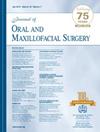The Effect of Le Fort I Osteotomy on Nasal Tip Rotation in Dynamic Smile
IF 2.6
3区 医学
Q2 DENTISTRY, ORAL SURGERY & MEDICINE
引用次数: 0
Abstract
Background
The nasal region is an essential component of facial aesthetics and is a crucial evaluation parameter in orthognathic surgery planning. Although numerous studies have investigated static changes in the nasal region at rest, dynamic changes during facial expressions such as smiling following Le Fort I surgery have not yet been evaluated.
Purpose
The aim of this study was to measure and compare the nasal tip rotation with smiling before and after orthognathic surgery.
Study design
This retrospective study examines data from maxillary advancement patients treated at Medipol Mega University Hospital (Istanbul, Türkiye) between 2018 and 2024. Patients with segmental Le Fort I surgery, maxillary asymmetry, vertical movements greater than 2.5 mm, a history of Le Fort surgery, trauma or septoplasty/rhinoplasty, craniofacial syndrome, cleft lip/palate patients, were excluded.
Predictor variables
The predictor variable was maxillary advancement magnitude (mm) and it was divided into 2 <6 mm or ≥6 mm.
Main outcome variable
The outcome variable was the angle differences between the lines drawn from the nasion to the nasal tip in resting and smiling profile photographs. The timing of resting and smiling profile photographs was reported as preoperatively (T0) and postoperatively (T1).
Covariates
Sex and age were considered covariates.
Analyses
Paired t-test and Wilcoxon signed-rank test were used to compare pre-operative and postoperative differences within each group. A P value <.05 was considered significant.
Results
The sample was composed of 48 subjects with a mean age of 24.23 (6.14) and 23 (47.9%) were male. The mean preoperative nasal tip rotation difference between rest and smiling was 1.57° (0.86), the mean postoperative nasal tip rotation difference was 1.30° (0.71). The nasal tip rotation difference decreased between pre-operative and postoperative periods. While the difference between the mean preoperative 1.36° (0.80) and postoperative dynamic nasal tip rotation 1.16° (0.66) in group 1 was not statistically significant (P = .2), the difference in group 2's mean preoperative 1.78° (0.88) and postoperative 1.43° (0.76) was statistically significant (P = .016).
Conclusions
In patients with more than 6-mm maxillary advancement, nasal tip rotation difference was significantly reduced during dynamic smile after orthognathic surgery.
Le Fort I型截骨术对动态微笑患者鼻尖旋转的影响。
背景:鼻区是面部美学的重要组成部分,也是正颌手术计划的重要评价参数。尽管许多研究已经调查了静止时鼻腔区域的静态变化,但Le Fort I手术后面部表情(如微笑)的动态变化尚未得到评估。目的:本研究的目的是测量和比较正颌手术前后的鼻尖旋转与微笑。研究设计:本回顾性研究调查了2018年至2024年在Medipol Mega大学医院(伊斯坦布尔,土耳其)治疗的上颌进展患者的数据。排除部分Le Fort I手术患者,上颌不对称,垂直运动大于2.5 mm, Le Fort手术史,创伤或鼻中隔成形术/鼻成形术,颅面综合征,唇裂/腭裂患者。预测变量:预测变量为上颌前移幅度(mm),分为2个主要结果变量:主要结果变量为静息和微笑侧面照片中鼻尖至鼻尖的线夹角差。休息和微笑侧面照片的时间分别为术前(T0)和术后(T1)。协变量:性别和年龄被视为协变量。分析:采用配对t检验和Wilcoxon符号秩检验比较各组术前、术后差异。结果:样本共48例,平均年龄24.23岁(6.14岁),男性23例(47.9%)。术前休息与微笑鼻尖旋转差值平均为1.57°(0.86),术后鼻尖旋转差值平均为1.30°(0.71)。术前和术后鼻尖旋转差异减小。组1术前平均1.36°(0.80)与术后平均1.16°(0.66)的差异无统计学意义(P = 0.2),组2术前平均1.78°(0.88)与术后平均1.43°(0.76)的差异有统计学意义(P = 0.016)。结论:上颌前移大于6mm的患者,正颌手术后动态微笑时鼻尖旋转差异明显减小。
本文章由计算机程序翻译,如有差异,请以英文原文为准。
求助全文
约1分钟内获得全文
求助全文
来源期刊

Journal of Oral and Maxillofacial Surgery
医学-牙科与口腔外科
CiteScore
4.00
自引率
5.30%
发文量
0
审稿时长
41 days
期刊介绍:
This monthly journal offers comprehensive coverage of new techniques, important developments and innovative ideas in oral and maxillofacial surgery. Practice-applicable articles help develop the methods used to handle dentoalveolar surgery, facial injuries and deformities, TMJ disorders, oral cancer, jaw reconstruction, anesthesia and analgesia. The journal also includes specifics on new instruments and diagnostic equipment and modern therapeutic drugs and devices. Journal of Oral and Maxillofacial Surgery is recommended for first or priority subscription by the Dental Section of the Medical Library Association.
 求助内容:
求助内容: 应助结果提醒方式:
应助结果提醒方式:


